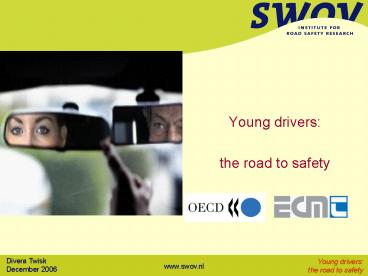Young drivers: PowerPoint PPT Presentation
1 / 24
Title: Young drivers:
1
- Young drivers
- the road to safety
2
Objective
- An up- to-date overview
- problem characteristics,
- contributing factors
- effective solutions
- Appealing to and inspiring for policymakers in
all OECD countries - Countries differ in history, culture,
motorization level, economy no one size fits
all - Does create a feel of urgency and reasons for
action - Discusses implementation strategies
3
Who are we?
- A group of researchers and policymakers from most
OECD countries - Inspired by
- many good review studies
- (limited) databases from WHO, IRTAD
- additional analyses from individual countries
- And several consultation rounds
- experts and policymakers (all over the world)
4
What do you find in the report?
- Accident frequency and characteristics for OECD
countries - Economic costs
- Forecasted future levels of Young Driver risk
- Literature on contributing factors effective
countermeasures - Promising new measures
- Views on implementation strategy
5
The distribution of death causes byage in OECD
countries
6
The distribution of death causes byage in OECD
countries
TRAFFIC Single greatest killer of youngsters
15- 24 In OECD 25.000 per year
7
Magnitude, costs and forecast
- Young drivers 27 of all driver fatalities but
are only 10 of the population in OECD countries - For each killed young driver about 1.3 others
die - Costs of fatalities amount e.g in US to 40.8
billion (2002) for 15-20 yr old crashes
(including passengers) - Young driver fatalities worldwide will increase
due to economic growth and motorization in
developing countries
8
The Problem, Writ Large
Driver Crash Involvement per Million Miles
Travelled, by Driver Age US, 2001-2002
9
The Circumstances Time of Day
- 18-25 Year-Olds Killed in Road Crashes, by Hour
and Day - European Union 15 (minus Germany), 2004
Source EU
10
Factors behind the problem
- Immaturity
- Age
- Biological brain development limitations
- Inexperience
- Poor higher order skills
- Unsufficient automation
- Gender
- High risk groups (young male drivers)
- Young females benefit from safety improvements
- Young males do not
- Risk aggravating factors
- Speed, young passengers, night driving, alcohol
and drugs - High risk of combined use of illicit drugs
alcohol
11
(No Transcript)
12
High benefits from general road safety
- Safe countries have safe young drivers
- Strict drink and drug-driving laws and enforcement
- Seatbelt
- Vehicle engineering
13
Infrastructure
14
Does this help?
15
16
Targeted measures are also necessary
- Licensing age raise age for solo driving
- Delay licensing
- Avoid migration to more unsafe motorized two-
wheelers
17
Priority measures 1 more drivingexperience
before solo driving
- Pre-license training with higher levels of
practice under supervised driving conditions - Indications are increasing accompanied practice
from current levels - (25 50 hrs) towards 120 hrs could reduce young
driver accidents considerably in first two years
of solo driving and be cost-effective
18
Priority measures 2 protection in solo driving
- zero alcohol for young drivers (widely accepted)
- restrictions on peer age passengers
- Restrict night-time driving (more difficult to
implement) - restrictions can be lifted progressively as
drivers gain experience
19
Priority measure 3 Driver training and
examination
- Focus on self-evaluation and risk increasing
factors - Research benefits of driver training (GDE)
- Improve driving test
- High validity
- High reliability
- Free of corruption
- Key elements in test are key elements in training
20
(No Transcript)
21
Priority measure 4 new technology
- Explore, develop and test technology
- Monitoring of solo driving restrictions (smart
key) - Rewards and enforcement green box
- Giving useful driver support (not yet available)
22
Incentives and communication
- Inform and persuade improve communication
- Entertainment and video games
- Involve parents
- Insurance companies
- The health sector
23
Managing change
- Communicate extent of the problem
- The need to act endorsed by high level decision-
makers - Inform stakeholders
- Link young driver measures closely to national
road safety strategies (specific targets?) - Coordinate on different levels
- Flexible introduction of measures evaluation
- Consider social equity impacts
- Learn from others
24
A VISION
- To create a situation in which
- overall road safety continually improves,
- the differences in risk levels between young and
older drivers are greatly reduced, - especially with regard to young male drivers.

